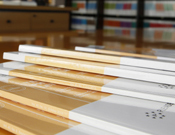Article
Thermophysical Properties of Materials
2009. V. 47. № 5. P. 628–634
Utkin A.V., Yakushev V.V., Anan'in A.V., Tatsii V.F., Zhukov A.N., Dremin A.N., Bochko A.V., Kuzin N.N.
Shock compressibility and spallation strength of cubic modification of polycrystalline boron nitride
Annotation
Methods of shock-wave physics are used to perform experimental investigations of the elastoplastic and strength properties of cubic modification of polycrystalline boron nitride. The samples are prepared by pressing to a pressure of $7$–$8$ GPa at a temperature of $1700$–$1800^{\circ}$C and rank just a little below diamond in hardness. The measurements are performed under conditions of the samples being acted upon by plane shock waves with the pressure behind the front of up to $85$ GPa and duration of $\sim10^{-6}$ s. It is demonstrated that a two-wave configuration consisting of an elastic precursor and a plastic compression wave is formed at the amplitude of shock compression of over $60$ GPa. The dynamic yield strength, determined by the amplitude of elastic precursor, depends on the structure of samples and varies in the range from $31$ to $49$ GPa. The dynamic strength, measured under conditions of pulsed tension in expansion waves, is likewise defined by the structure of samples and, in the elastic region of deformation, lies in the range from $0.7$ to $1.6$ GPa.
Article reference:
Utkin A.V., Yakushev V.V., Anan'in A.V., Tatsii V.F., Zhukov A.N., Dremin A.N., Bochko A.V., Kuzin N.N. Shock compressibility and spallation strength of cubic modification of polycrystalline boron nitride, High Temp., 2009. V. 47. № 5. P. 628
Utkin A.V., Yakushev V.V., Anan'in A.V., Tatsii V.F., Zhukov A.N., Dremin A.N., Bochko A.V., Kuzin N.N. Shock compressibility and spallation strength of cubic modification of polycrystalline boron nitride, High Temp., 2009. V. 47. № 5. P. 628







